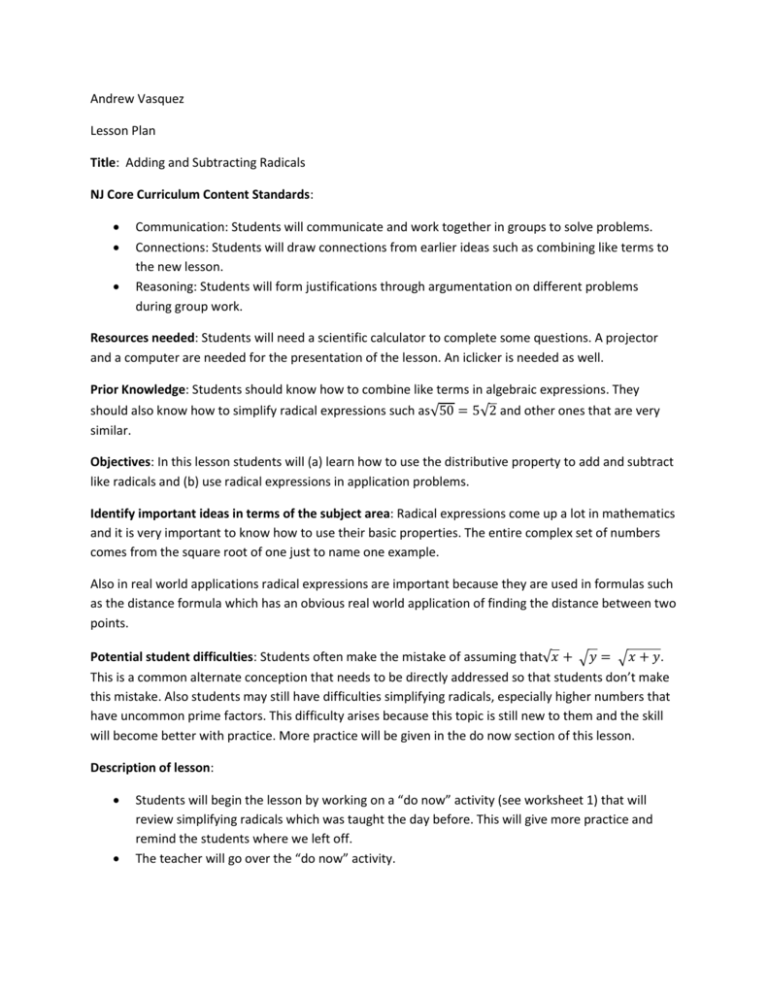Lesson Plan - WordPress.com
advertisement

Andrew Vasquez Lesson Plan Title: Adding and Subtracting Radicals NJ Core Curriculum Content Standards: Communication: Students will communicate and work together in groups to solve problems. Connections: Students will draw connections from earlier ideas such as combining like terms to the new lesson. Reasoning: Students will form justifications through argumentation on different problems during group work. Resources needed: Students will need a scientific calculator to complete some questions. A projector and a computer are needed for the presentation of the lesson. An iclicker is needed as well. Prior Knowledge: Students should know how to combine like terms in algebraic expressions. They should also know how to simplify radical expressions such as√50 = 5√2 and other ones that are very similar. Objectives: In this lesson students will (a) learn how to use the distributive property to add and subtract like radicals and (b) use radical expressions in application problems. Identify important ideas in terms of the subject area: Radical expressions come up a lot in mathematics and it is very important to know how to use their basic properties. The entire complex set of numbers comes from the square root of one just to name one example. Also in real world applications radical expressions are important because they are used in formulas such as the distance formula which has an obvious real world application of finding the distance between two points. Potential student difficulties: Students often make the mistake of assuming that√𝑥 + √𝑦 = √𝑥 + 𝑦. This is a common alternate conception that needs to be directly addressed so that students don’t make this mistake. Also students may still have difficulties simplifying radicals, especially higher numbers that have uncommon prime factors. This difficulty arises because this topic is still new to them and the skill will become better with practice. More practice will be given in the do now section of this lesson. Description of lesson: Students will begin the lesson by working on a “do now” activity (see worksheet 1) that will review simplifying radicals which was taught the day before. This will give more practice and remind the students where we left off. The teacher will go over the “do now” activity. The teacher will then start the lesson by going over combining like terms and what it means for two terms to be like terms. Some simple problems will be given to refresh their memory and students can use the iclickers to answer as a class. Then students will be given questions on adding radical expressions and students will make the connection between the two ideas. Students will then be given a worksheet (see worksheet 2) that will have many more examples of adding and subtracting radical expressions. Here students will get practice on a variety of questions relating to the topic including application problems. The class will then wrap up by reviewing the worksheet. Time Table Clock 0-5 min Title Do Now 5-8 min Review Do now 8-18min Discussion 18-35min Practice Problems 35-45min Review practice problems Students doing Completing worksheet 1 Attending Taking notes and answering the iclicker questions Completing worksheet 2 Attending and Correcting their mistakes Me doing Observing student progress Explaining do now answers Leading the discussion on making the new connection Assisting students who need help Explaining the answers for the practice problems. Modifications: All lessons will use heterogeneous groups in terms of mathematical ability and performance so students who are struggling can work with more sophisticated students. Homework: (see worksheet 3) Students will be asked questions that assess each of the objectives. Worksheet 1: Do Now Simplify 1. 2√18 2. √4𝑥 3 3. 5√32𝑥 3 𝑦 4. 7√6𝑥 2 𝑦 3 5. 𝑥𝑦√150𝑦 Worksheet 2: Practice Problems Simplify by adding and subtracting like radicals 1a. √7 + 5√7 − 2√7 3 3 1b. 6√𝑥 − √4 − 5√𝑥 + 2√4 3 3 1c. 3 √𝑥 + 2 √𝑥 + √𝑥 − 8√𝑥 Simplify by reducing the radicals to its simplest form then add and subtract like radicals 2a. √45𝑥 + 3√20𝑥 2b. 5√𝑥 3 − 𝑥 √4𝑥 3 3 2c. √54𝑦 5 + 4𝑦 √2𝑦 2 3 3 3 2d. √6𝑥 4 + √48𝑥 − √162𝑥 4 Rationalize the denominator and then simplify 3. √7 − 5 √7 Find the perimeter of the triangle 4. √16𝑥 √𝑥 Worksheet 3: Homework 3√𝑥 There will be plenty of problems to make sure they get enough practice. It will include problems like these and will get increasingly more difficult as it goes along. 3 or so problems of this difficulty: 3√2 − √2 3 or so problems like this: 8√2 + 6√2 − 5√2 3 3 A few like this: √6𝑥 4 + 𝑥 √48𝑥 A couple that involve rationalizing fractions first: √5 − 3 √5 Some concept questions: Place the correct symbol between the numbers (<, >, or =) √7 + √18 √7 + 18 Also application problems such as finding the perimeter similar to the one in worksheet 2.



